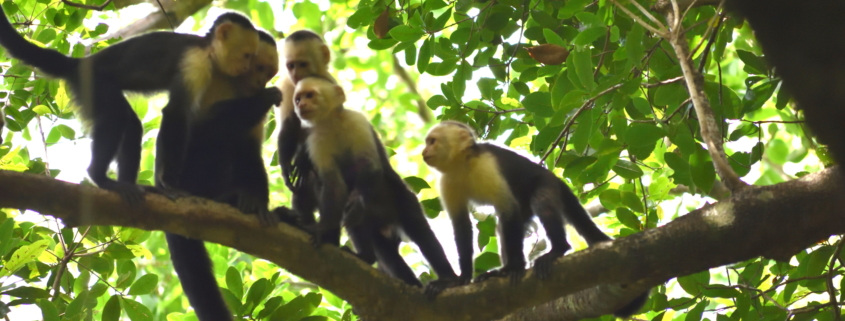Cultural dynamics and the relationship between life history and learning processes in capuchins
The Lomas Barbudal Monkey Project’s primary focus currently is to investigate how behavioral repertoires of individuals and social groups change over time, due to the processes of innovation and social transmission. What features of behaviors make them more or less likely to be invented, socially transmitted, and retained? What factors make certain individuals more or less likely to invent new behaviors, or copy behaviors from other individuals? What properties of social relationships make a pair of monkeys more effective at transmitting knowledge and skills to one another? And what characteristics of social groups – e.g. group size and composition, or social network properties – promote or inhibit the invention, spread and retention of behavioral traits?
We know that behavioral repertoires shift over the course of the lifespan, as learning strategies shift. During some phases of life, individuals are more reliant on trial-and-error learning, whereas during other phases they are more inclined to copy others’ behavior, or to just stick with what they have already learned. These shifts in strategy are dependent not only on age, but on the behavioral domain, or type of problem the animal is trying to solve. Current models of cultural evolution have largely ignored the role of age structure of populations as a factor influencing the rise, spread and extinction of behavioral traits. We hope to remedy this oversight in the literature by collaborating with modelers and using our data set to ground truth models of cultural evolution.
Current theorizing about the evolution of the human species’ advanced cognitive skills and capacity for cumulative cultural evolution are difficult to test, because evolutionary scenarios involve a chain of events that has occurred only once, in humans. For example, part of the human success story culminating in complex cumulative culture involves the combination of large brain to body ratio, slow development (with long juvenile phases and long post-reproductive phases), cooperative breeding, theory of mind, an extractive foraging niche, and language. Capuchins have most of these key features, though they lack language and are not as extreme as humans in the degree to which they have a long post-reproductive phase, obligatory cooperative breeding, and advanced theory of mind. Still, the presence of these traits in rudimentary form affords the opportunity for scientists to investigate how these traits might select for certain types of learning strategies and cultural processes.
For information about being a field assistant for this project please see: https://lbmp.anthro.ucla.edu/how-to-help/internships/
Our current grant support for 2020-2021 permits us to cover room and board during these internships, and to reimburse plane fares to the field site at the end of the 1-year commitment.
We are grateful to the following agencies for funding this work in progress: The Leakey Foundation, The National Geographic Society, the Templeton World Charity Foundation, and the National Science Foundation (grant #1919649).




Leave a Reply
Want to join the discussion?Feel free to contribute!